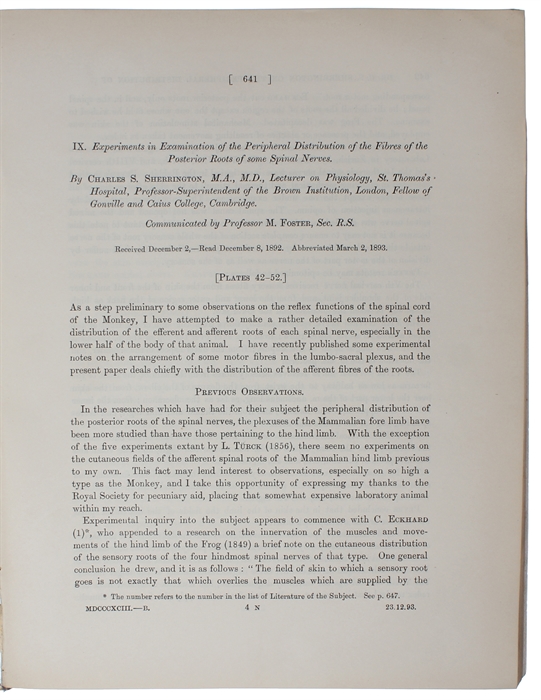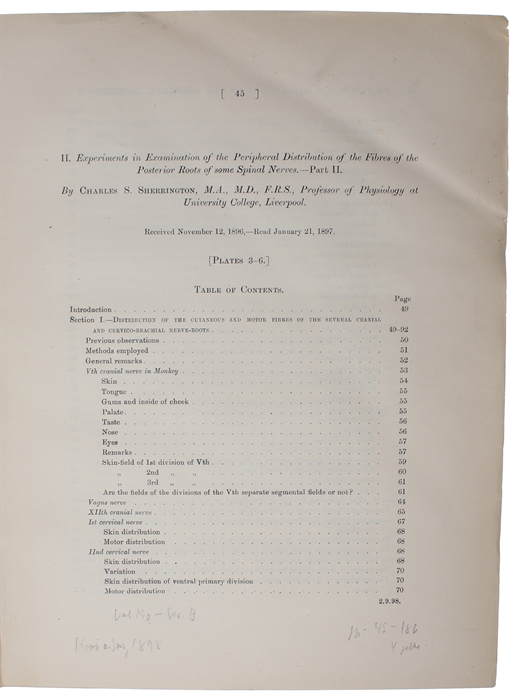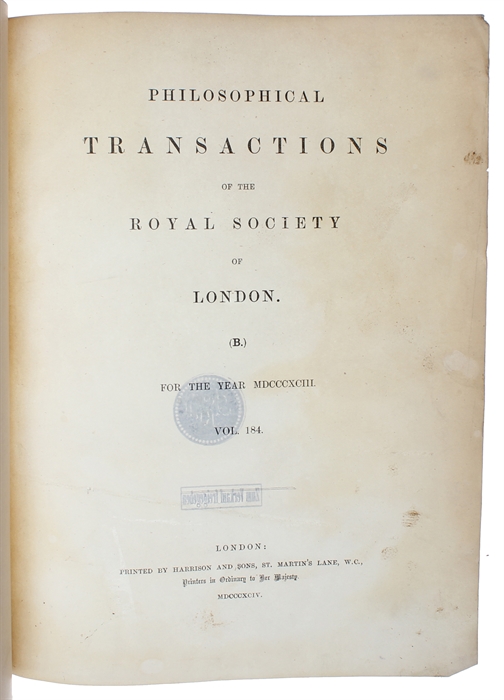INTRODUCING THE FUNDAMENTAL TERMS AND CONCEPTS OF NEUROSCIENCE
SHERRINGTON, CHARLES SCOTT. - A MILESTONE WORK IN NEUROPHYSIOLOGY COINING "RECIPROCAL INNERVATION".
Experiments in Examination of the Peripheral Distribution of the Fibres of the Posterior Roots of some Spinal Nerves. Received December 2, - Read December 8, 1892. Abbreviated March 2, 1893. (Part I) (+) Experiments in Examination of the Peripheral Distribution of the Fibres of the Posterior Roots of some Spinal Nerves. - Part II. Received November 12, 1896, - Read January 21, 1897.
(London, Harrison and Sons, 1898).
4to. No wrappers as extracted from "Philosophical Transactions", Volume 184, Section B + Volume 190 - Series B. - Pp. 641-763, textillustrations and 11 plates (10 photographic) and pp. 45-186, textillustr. a. 4 plates. Clean and fine.
First appearance of these groundbreaking papers in modern neurophysiology by "the most important neurophysiologist Britain has produced, and perhaps the most remarkable neuroscientist ever to have lived." (Grolier Club "One Hundred Books famous in Medicine", p. 326). - "The experiments on reflex action carried out by Pavlov and by Sherrington provided a foundation for the objective treatment of human psychological problems, in particular the theory of behaviourism."(PMM: 397, listing Sherrington's book from 1906). "The data, terms, and concepts that he introduced have become such a fundamental part of the neuroscience that it is perhaps not surprising their authorship is often forgotten: such terms as proprioceptive, nociceptive, recruitment, fractionation, occulusion, myotatic, neuron pool, motoneuron, and synapse, and such concepts as the final common path, the motor unit, the neuron threshold, central excitatory and inhibityory states, proprioception, reciprocal innervation, and the integrative action of the nervous system."(DSB).
"His first steps (in investigation of the nervous system) were to concentrate upon the reflex functions of the cord rather than on the more complex field of the brain; to choose an appropriate experimental animal, the monkey; and to make parallel control and comparison experiments on lower forms to establish the necessary points of anatomical knowledge... Sherrington's basic method was to study simple motor acts which could be made to occur in isolation, correlating his exacting analyses of input-output relations of reflex responses with anatomical and histological data... The effects of decerebration had been partially described by many earlier workers, such as Magendie, Bernard, and Flourens, but it was Sherrington who named decerebrate rigidity and, in a fundamental paper of 1898 (the paper offered) and later publications, established it as a phenomenon in its own right and as a major tool for examining the reflex functions of the spinal cord, particularly the nature of inhibition... He first used the term "reciprocal innervation" (in the paper offered), read before the Royal Society on 21 January 1897; the term he explained, denoted the "particular form of correlation" in which one muscle of an antagonistic couple is relaxed as its mechanical opponent actively contracts... Four months later, as the Royal Society's Croonian lecturer, he proposed his classic definition of riciprocal innervation as that form of of coordination in which "inhibito-motor spinal reflexes occur quite habitually and concurrently with many of the excito-motor." (DSB XII, pp. 402-3). - This lecture is printed as part IV of the second paper offered.
Sir Charles Scott Sherrington's research, spanning more than 50 years, laid the foundations for modern neurophysiology. He maintained that the most important function of the nervous system in higher animals is the coordination of the various parts of the organism. Although best known for his long series of studies on spinal reflexes, he made equally great strides in the physiology of perception, reaction, and behaviour. He was the first to adequately study the synapse and originated the term. He also introduced the term exterioceptor, proprioceptor and viscerocepter. In 1932 he shared the Nobel Prize in Physiology or Medicine with Edgar Douglas Adrian.
Order-nr.: 46446



